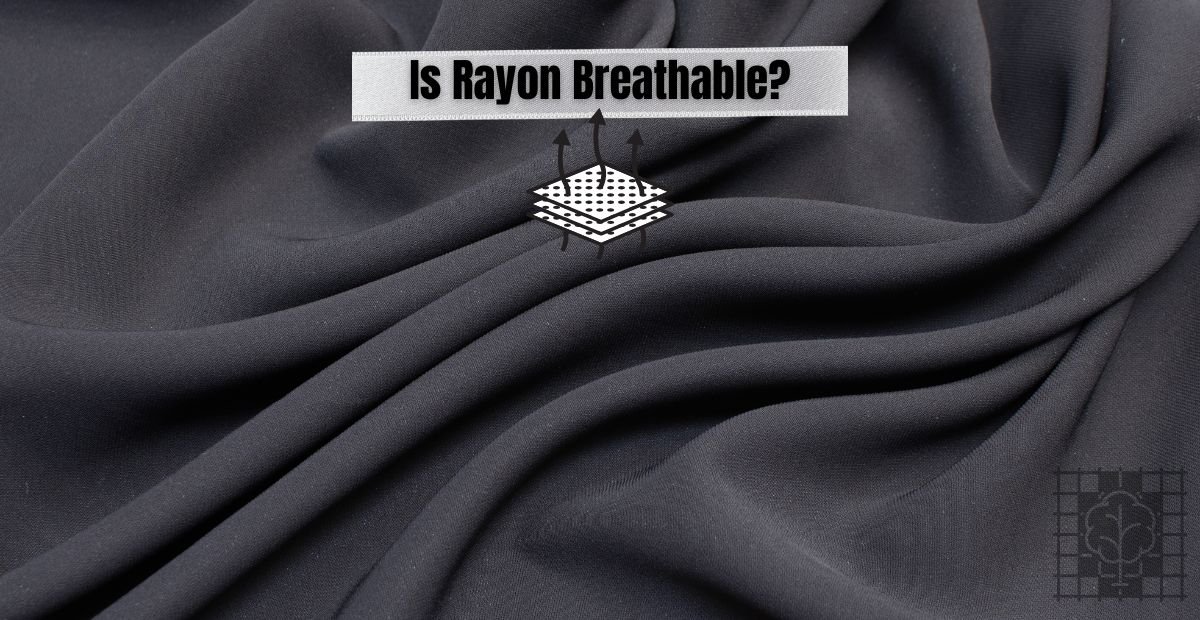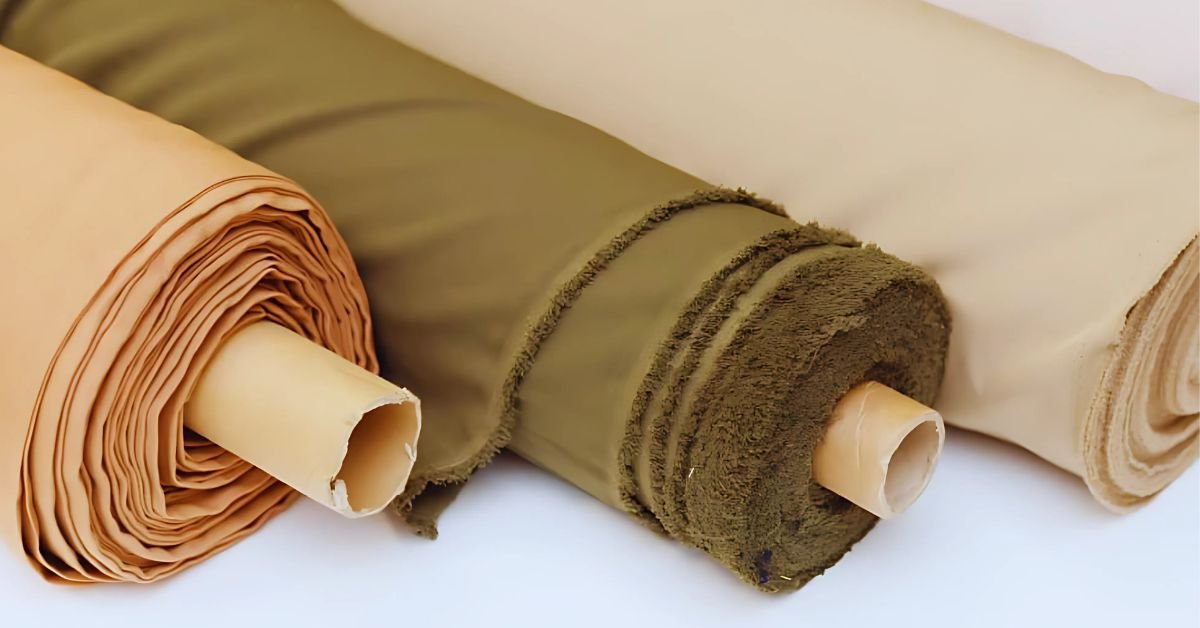Introduction-
When individuals go out to purchase summer clothes, they desire clothes that are cool and comfortable. This is why the question “Is Rayon Breathable or not?” can be raised frequently. Rayon is common in blouses, dresses and in active wear due to its ability to flare and it is also soft against the skin.
Nevertheless, a lot of customers are still not certain whether rayon is able to breathe like natural materials. Its breathability can be understood to assist you in selecting an appropriate fabric to wear during summer, traveling, or throughout the year.
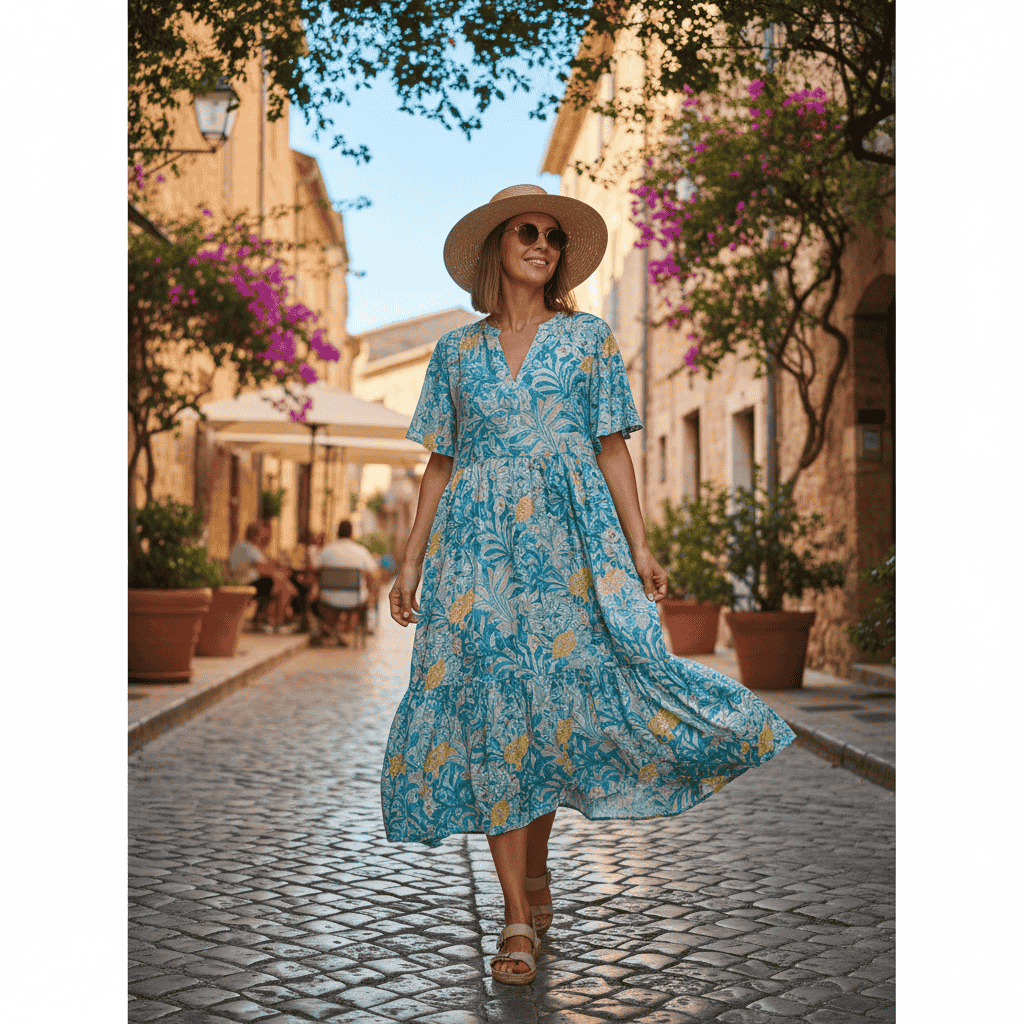
What is Rayon?
Cellulose-Based Fiber
Rayon is a semi-synthetic fiber that is produced out of plant cellulose. It is made out of chemically processed wood pulp into fine fibers. Actually, the structure of rayon is the same as that of cellulose thus it tends to feel like cotton or linen. Other types of rayons are even designed to imitate higher end fabrics like wool or silk.
Dresses & Blouses: Woven rayon may find application in summer dresses, loose blouses and skirts. Its light fabric is drape-able and has gathers and prints that are not bulky.
Summer Tops & Pants: Rayon is popular in top and pants because of its lightweight airy feel in warm weather. Rayon is used in many summer collections because it is more comfortable.
Linings: Rayon is a soft fabric that is very breathable, which is why it is commonly used as a lining. Its smoothness allows the clothing to slide on and jackets and dresses are easier to wear.
Activewear Blends: Rayon is frequently combined with stretch fabrics in both work out and lounge wear. An example of this is modal rayon, which adds comfort and moisture retention to active wear, as a comfortable alternative to pure synthetics.
Is Rayon Breathable?
Yes – rayon is a fabric which is usually regarded as a breathable one. It is described by a lot of sources as soft and breathable, even most breathable and moisture absorbing. Due to its lightness and loose nature of weaving, air travels easily through rayon cloth. This practically involves a rayon shirt or dress that tends to be cool on your skin. Generally speaking, rayon clothes will make you feel a lot more comfortable in hot weather than most polyester synthetics do.
Rayon vs. Synthetic Fabrics
Rayon usually breathes much easier in comparison with artificial fibers. As an illustration, the tight weave of polyester has the potential to trap heat and reach moisture, which makes it almost a plastic wrap on your skin. Nylon similarly holds heat. In comparison, the natural cellulose fibers in rayon do not trap heat but allow it to pass through. Polyester also fails to absorb water and thus it is clammy, unlike rayon that is able to absorb the sweat and then begins to evaporate cooling you. Simply put, rayon is drier and cooler than polyester or nylon under hot weather.
Rayon vs. Natural Fabrics
Rayon compares well with natural fabrics. Cotton is highly permeable and incredibly absorbent and this keeps you cool in summer. Rayon absorbs water as well to keep one cool and yet cotton can absorb more water on average. Linen is more airy; it is loose and therefore, linen is extremely cool in hot weather. The rayon is not as rough and coarse as linen, but linen would cool down more quickly. Silk is not only lightweight, but breathable as well. Rayon also feels like silk. Practically, silk and rayon are just as cool but silk is cheaper and more delicate. Generally, rayon is highly breathable, but pure cotton or linen can replace it, in the extreme conditions.
Factors That Affect Rayon’s Breathability
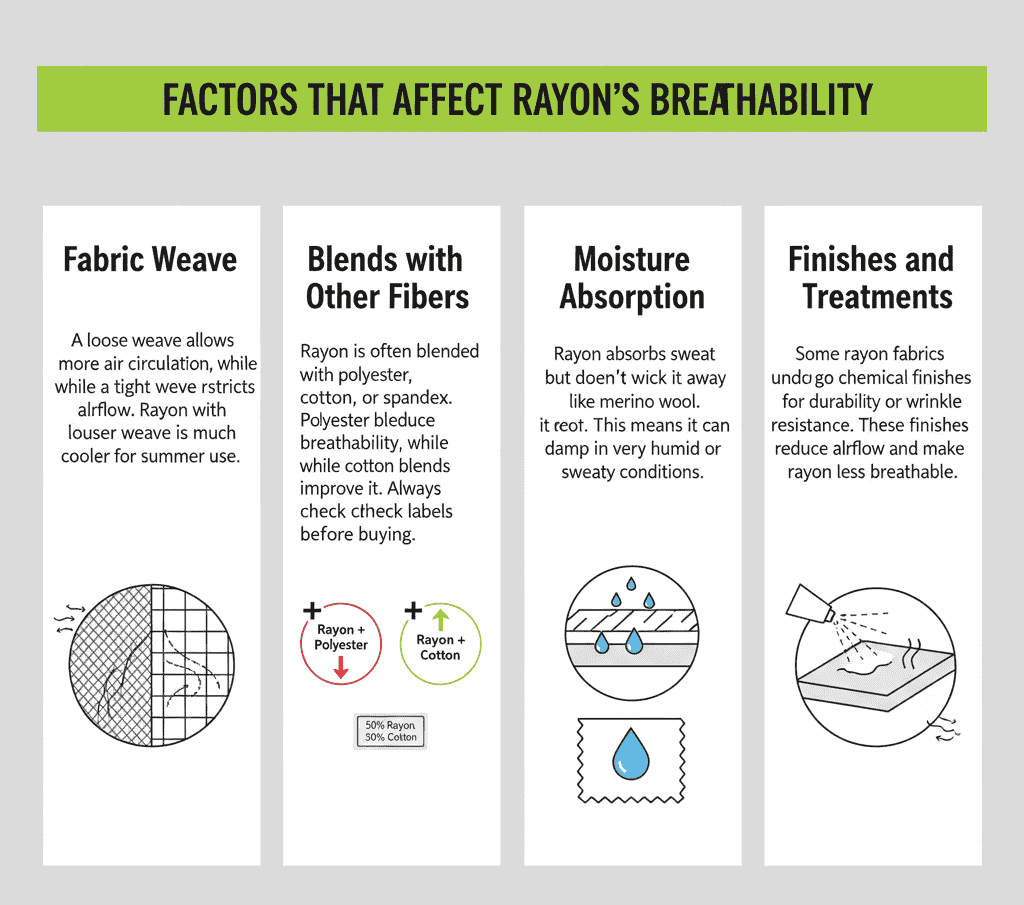
Fabric Weave
The fabric or knit made of rayon has a drastic impact on airflow. Generally, there is more air movement in a looser weave. As an example, a rayon gauze or crepe (open weave) will be lighter than a tight-woven rayon satin. According to the outdoor retailers, a loose weave or a thin knit contributes significantly to the breathability. On the other hand, thick rayon clothing (such as heavy challis or jersey) will keep in more of the heat. Theoretically, the lightweight of a rayon gauze dress is lighter to wear than the heavyweight rayon shirt.
Blends with Other Fibers
Rayon is frequently mixed, and the other fibers modify its breathability. Blends are normally breathable when combined with cotton or linen. Blends with polyester, nylon, or spandex will, however, decrease airflow. As an illustration, a rayon/polyester mix will be less cool than 100% rayon, since polyester is a heat-retaining fabric. It helps to look at labels: the more synthetic a product is, the less breathable the fabric. A rayon/spandex shirt can be a bit hot, but a rayon/cotton blend is cooler.
Moisture Absorption
Rayon has the ability to absorb moisture easily thus aiding cooling. It has a reasonable capacity of absorbing sweat and later evaporating on its surface. Actually, rayon allows the body to stay cool, by absorbing sweat. But rayon does not actively wick moisture away like wool, it just keeps water dry until it evaporates. It implies that during intense sweating, rayon may not dry, and it may stick to the skin. Its absorption even works in moderate heat conditions, provided the fabric is not over-saturated.
Finishes & Treatments
Other rayon materials receive special finishes(such as wrinkle-resistance or water-resistance finishes). With these finishes, there is the ability to block the fibers and stop air. As an example, the threads will be covered with a resin finish, preventing wrinkles, and make the cloth less permeable. The water-repellent treatments also prevent the passage of moisture and air. Practically, the most breathing is made possible by bare rayon (without any additional coating). When there is a label on a rayon garment that it is water-resistant or treated, anticipate that it will not feel airy. That is, plain rayon breathes the most.
Rayon in Hot Weather: Is it Good for Summer?
And in summer the question arises: Can rayon be used as hot weather clothing? Here’s a breakdown.
Pros of Rayon in Hot Weather
- Lightweight- Feels lightweight and easy against the skin.
- Cool Touch – Is clean, cool and smooth.
- Drapey Design – Falls beautifully to chic summer outfits.
Cons of Rayon in Hot Weather
- Wrinkles Easily – Appears to be untidy after a couple of hours of use.
- Not Sweat-Resistant -Soaks up the moisture and can stick to the skin.
Rayon vs. Other Fabrics for Breathability
Rayon vs. Cotton (Breathability)
Rayon as well as cotton is breathable. Cotton is highly permeable and soaks up a lot of water. In case of wetness of cotton it remains cool and enables you to shed off sweat. Rayon is also breathable and it dries quicker. When completely wet, cotton would feel colder than when dry because it is heavier and rayon when it is dry because it is light. Both allow air to pass through, but cotton is able to deal with the heavy sweat. And, on the off-chance that you get hot, 100% cotton may possibly surpass rayon in a few cases, nevertheless, rayon provides a slick feel that is not present in cotton.
Rayon vs. Polyester
Polyester does not breathe very well; it is a trap to heat. It is mentioned by many sources that polyester fibers may pose as a plastic wrap around your skin. Rayon is a cellulose fiber, which allows air to pass out. The rayon takes up water rather than throws it off and thus you gain a little cooling effect through the evaporation. Effectively, rayon would be far more comfortable than polyester when it gets hot. Polyester dries fast but it is clammy and rayon is cooler and more natural to the skin.
Rayon vs. Linen
Linen is generally more breathable in its raw form than rayon. Its weft is loosely woven and stiff in the sense that it lets as much air pass through it as possible and thus it feels very cool in hot weather. Rayon is lighter and less coarse and it is more luxurious to wear. Practically, linen will be crisp and cooler; rayon will be a little warmer, and much more comfortable to the touch. Linen would prevail in case the ultimate cooling is desired. But rayon is also typically used when the soft, light touch (or a better fall) is needed.
Rayon vs. Silk
Silk is light and possesses good ventilation. It also possesses natural capacity to control temperature. The hand-feel of silk is almost identical to that of rayon. Both allow skin to breath fairly well in terms of airflow. Silk can get a little cooler with sweat and it is more stretchy. Rayon is much cheaper, however. They both are cool and soft on the skin and rayon provides that luxurious feeling at a reasonable cost.
| Fabric | Breathability | Moisture Absorption | Notes |
|---|---|---|---|
| Rayon | Moderate–High (good airflow) | Absorbent, but does not wick quickly | Soft, silky feel; drapes well |
| Cotton | Very High | Very high; absorbs large amounts | Natural fiber; stays comfortable when wet |
| Polyester | Low | Very low; quick-drying, moisture-repelling | Traps heat; synthetic |
| Linen | Very High | High (but no active wicking) | Ultra-breathable; lightweight, but wrinkles |
| Silk | High | Moderate | Luxuriously soft; natural temperature regulation |
Advantages of Rayon Beyond Breathability
- Delicacy & Softness: Rayon is soft and silky. It has the texture that is often likened to silk or soft cotton. This makes rayon clothing very comfortable to wear either as a casual or dress up. Rayon is the favorite of many who wear it in blouses or scarves since it is skin friendly and falls well.
- Draping & Versatility: Rayon looks fantastic on the body and thus adapts to most styles (collected skirts, ruffles, a loosely-fitting top). It is also a good recipient of dye, thus giving bright colors and prints. It is this flexibility that has seen rayon become a must-have in a summer dress, kimonos, and fashion-forward tops. It is also easy to layer because it is lightweight.
- Silk Substitute: Rayon is a silk that resembles the luxurious appearance of this fabric at a lot lower cost. That is, you have a comparable glossy look and feel as silk at a low cost material. Numerous evening dresses, lining and lingerie utilize rayon as a means of achieving that same, sophisticated look but without the expense of true silk. This renders rayon a solution to silk-like comfort at a low cost.
Limitations of Rayon Fabric
Rayon has its disadvantages, which customers ought to be aware of.
Wrinkles Easily
Rayon wrinkles easily and this might interfere with its smooth look.
Loses Strength When Wet
When the cloth is wet it becomes weak and thus vulnerable to being torn apart.
Needs Careful Washing
Rayon mostly needs hand washing or dry cleaning to be durable.
Best Uses for Rayon Clothing
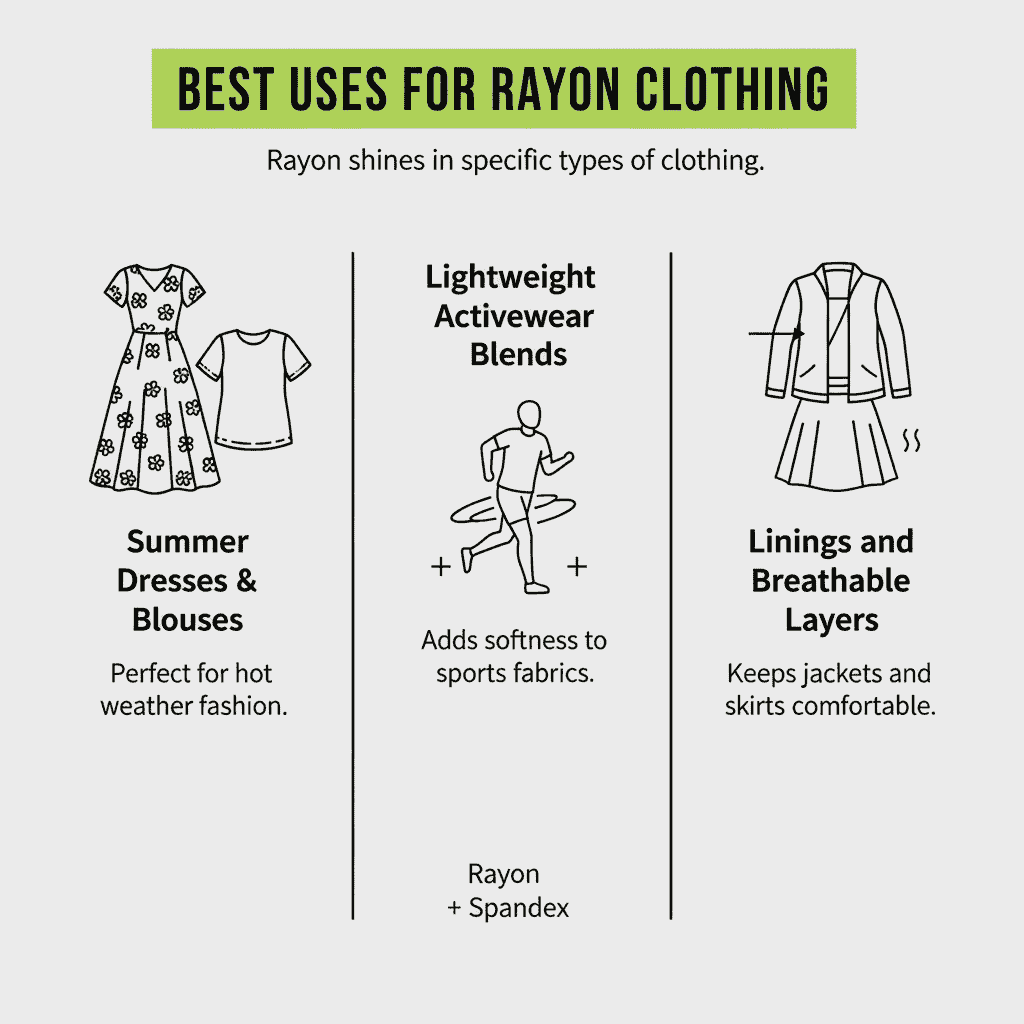
- Summer dresses & blouses: The cool, soft feel of rayon makes it a great option for sundresses, tops, and skirts. It looks elegant yet lightweight, making it a go-to for warm weather. rayon’s flowy drape and comfort is the reason many casual summer dresses, printed blouses, and lightweight skirts are made of this fabric.
- Light activewear & loungewear: Blended with spandex or nylon, rayon inclusions helps with breathability in active and lounge clothing. Modal rayon (a type of rayon) is commonly used in the fabric of yoga pants, workout shirts, and even underwear. For low-to-moderate activity, these rayon blends are great because they offer a soft hand and better airflow compared to pure synthetics.
- Linings & layers: As a lining or layering fabric, designers utilize rayon. It’s smooth texture decreases friction between clothing layers and breathability adds comfort under heavy items. Jackets, dresses and even some skirts have rayon linings. On hot days, it’s great for lightweight kimono or overshirt, giving breathable layer over other fabrics.
Conclusion-
So, is rayon breathable? The response is yes–with conditions. Lightweight, cool to touch and stylishly draped rayon makes it a good fabric to wear during summer. But it is easy to absorb moisture and gets wrinkled easily, which may be inconvenient in hot and highly humid environments.
To the consumers, rayon offers the compromise: it is more comfortable and breathable than polyester, cheaper than the silk and it is less weighty than cotton. Rayon can make a great fabric with proper care making it an excellent fabric in making stylish breathable clothes.
Read More>> About what is rayon fabric?
FAQs
Is rayon good for hot, humid weather?
Yes, rayon is cool and lightweight so it is the best option to use during hot weather. It enables air to pass so that the skin can be comfortable on hot summer days.
Does rayon make you sweat?
Nevertheless, when it is very humid it can stick to the skin when wet.
Rayon is not a sweat-giving fabric by itself as it is a breathable one. But it does not wick away the moisture, it absorbs it. This may render the cloth to be sticky on the skin during a humid climate.
Is rayon more breathable than polyester?
Yes, rayon is far more breathable than polyester and it permits a greater amount of air flow. Polyester is known to trap body heat that makes you feel warmer. Rayon is cooler and fresher feeling particularly in hot climates.
Can you wear rayon year-round?
Yes, it is possible to wear rayon at any time of the year with the proper styling. Summer dresses and blouses are perfect but it can also be worn in cooler temperatures under the layer. It can be worn all year round with care.

